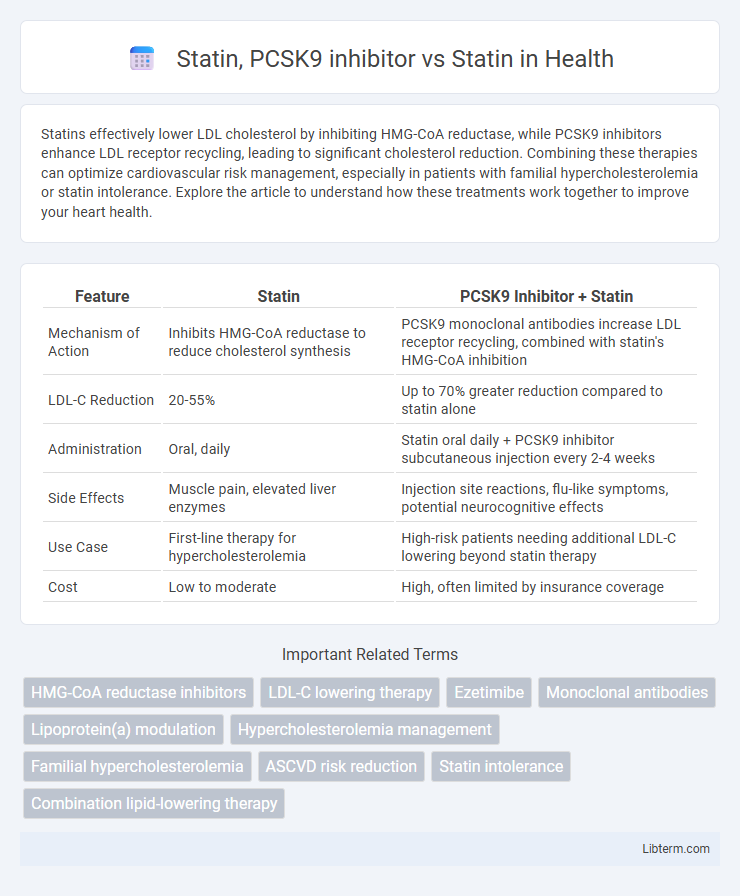Statins effectively lower LDL cholesterol by inhibiting HMG-CoA reductase, while PCSK9 inhibitors enhance LDL receptor recycling, leading to significant cholesterol reduction. Combining these therapies can optimize cardiovascular risk management, especially in patients with familial hypercholesterolemia or statin intolerance. Explore the article to understand how these treatments work together to improve your heart health.
Table of Comparison
| Feature | Statin | PCSK9 Inhibitor + Statin |
|---|---|---|
| Mechanism of Action | Inhibits HMG-CoA reductase to reduce cholesterol synthesis | PCSK9 monoclonal antibodies increase LDL receptor recycling, combined with statin's HMG-CoA inhibition |
| LDL-C Reduction | 20-55% | Up to 70% greater reduction compared to statin alone |
| Administration | Oral, daily | Statin oral daily + PCSK9 inhibitor subcutaneous injection every 2-4 weeks |
| Side Effects | Muscle pain, elevated liver enzymes | Injection site reactions, flu-like symptoms, potential neurocognitive effects |
| Use Case | First-line therapy for hypercholesterolemia | High-risk patients needing additional LDL-C lowering beyond statin therapy |
| Cost | Low to moderate | High, often limited by insurance coverage |
Overview of Statins: Mechanism and Uses
Statins function by inhibiting HMG-CoA reductase, a key enzyme in cholesterol synthesis, effectively lowering LDL cholesterol and reducing cardiovascular risk. They are widely prescribed for primary and secondary prevention of atherosclerotic cardiovascular disease (ASCVD) due to proven benefits in decreasing heart attacks and strokes. Statins also exhibit anti-inflammatory properties and improve endothelial function, making them a cornerstone in dyslipidemia management.
Introduction to PCSK9 Inhibitors: A New Era in Cholesterol Management
PCSK9 inhibitors represent a breakthrough in cholesterol management by targeting the protein responsible for LDL receptor degradation, thereby significantly lowering LDL cholesterol levels beyond what traditional statins achieve. Unlike statins, which inhibit HMG-CoA reductase to reduce cholesterol synthesis, PCSK9 inhibitors enhance the liver's ability to clear LDL cholesterol from the bloodstream. Clinical trials demonstrate that combining PCSK9 inhibitors with statins further reduces cardiovascular risk in patients with hypercholesterolemia and statin intolerance.
Comparative Mechanisms: Statins vs PCSK9 Inhibitors
Statins reduce cholesterol by inhibiting HMG-CoA reductase, decreasing cholesterol synthesis in the liver and upregulating LDL receptors to enhance LDL clearance. PCSK9 inhibitors, such as evolocumab and alirocumab, prevent PCSK9 protein from degrading LDL receptors, significantly increasing receptor availability and promoting higher LDL cholesterol removal from the bloodstream. While statins primarily reduce cholesterol production, PCSK9 inhibitors focus on preserving LDL receptor function, offering complementary mechanisms for lipid lowering.
Efficacy in Lowering LDL Cholesterol: Statin vs PCSK9 Inhibitor
PCSK9 inhibitors demonstrate superior efficacy in lowering LDL cholesterol compared to statins, with reductions often exceeding 60% versus statins' typical 30-50% range. Statins inhibit HMG-CoA reductase to reduce cholesterol synthesis, while PCSK9 inhibitors enhance LDL receptor recycling, resulting in greater LDL clearance from the bloodstream. Clinical trials like FOURIER and ODYSSEY have consistently shown that PCSK9 inhibitors achieve more profound LDL cholesterol lowering, especially in patients with familial hypercholesterolemia or statin intolerance.
Cardiovascular Outcome Benefits: Evidence Review
PCSK9 inhibitors, such as evolocumab and alirocumab, demonstrate a significant reduction in LDL cholesterol levels beyond what statins alone achieve, leading to improved cardiovascular outcomes including lower rates of major adverse cardiovascular events (MACE). Randomized clinical trials like FOURIER and ODYSSEY outcomes provide robust evidence that combining PCSK9 inhibitors with statins reduces the risk of myocardial infarction, stroke, and cardiovascular death more effectively than statin monotherapy. Statins remain foundational in lipid management, but PCSK9 inhibitors offer important incremental benefits for high-risk patients inadequately controlled by statins, supporting guideline recommendations for their use in secondary prevention.
Safety Profiles and Side Effects: Statins Compared to PCSK9 Inhibitors
Statins commonly cause muscle pain, increased liver enzymes, and potential risk of diabetes, while PCSK9 inhibitors generally have a favorable safety profile with injection site reactions being the most reported side effect. The risk of serious adverse events with PCSK9 inhibitors is low, making them a safer alternative for patients intolerant to statins. Long-term studies suggest statins' side effects may limit adherence, whereas PCSK9 inhibitors demonstrate sustained tolerability and effectiveness in lowering LDL cholesterol.
Patient Eligibility: Who Should Use Statin or PCSK9 Inhibitor?
Patients with high LDL cholesterol levels and established cardiovascular disease or diabetes typically qualify for statin therapy as first-line treatment. PCSK9 inhibitors are reserved for individuals who exhibit statin intolerance, have familial hypercholesterolemia, or fail to achieve target LDL cholesterol despite maximally tolerated statin doses. Clinical guidelines emphasize personalized risk assessment to determine eligibility for either statins or PCSK9 inhibitors in managing hyperlipidemia.
Cost and Accessibility: Economic Implications of Treatment Choices
Statins are widely available and cost-effective, often covered by insurance and available as inexpensive generics, making them the preferred first-line lipid-lowering therapy. PCSK9 inhibitors, although highly effective in reducing LDL cholesterol, remain significantly more expensive with limited accessibility due to high costs and insurance restrictions, impacting overall treatment affordability. Economic implications favor statins for large-scale population management, while PCSK9 inhibitors are typically reserved for high-risk patients who do not achieve target lipid levels with statins alone.
Combination Therapy: When to Use Both Statin and PCSK9 Inhibitor
Combination therapy with statins and PCSK9 inhibitors is recommended for patients with atherosclerotic cardiovascular disease (ASCVD) or familial hypercholesterolemia who do not achieve target LDL-C levels with statin monotherapy alone. Statins effectively reduce LDL cholesterol by inhibiting HMG-CoA reductase, while PCSK9 inhibitors enhance LDL receptor recycling, leading to a complementary and significant LDL-C reduction often exceeding 50-60%. This dual approach is particularly beneficial in high-risk individuals requiring aggressive lipid lowering to prevent cardiovascular events.
Future Directions in Lipid-Lowering Therapies
Emerging lipid-lowering therapies focus on combining statins with PCSK9 inhibitors to achieve unprecedented LDL cholesterol reduction, addressing patients with statin intolerance or inadequate response. Advanced gene-editing techniques and RNA-based therapies targeting PCSK9 show promise for more durable and personalized treatments. Ongoing clinical trials aim to define optimal dosing regimens and identify patient populations that benefit most from these innovative strategies in cardiovascular risk management.
Statin, PCSK9 inhibitor Infographic

 libterm.com
libterm.com